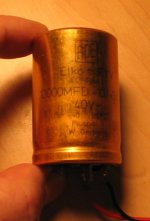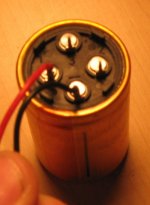Does anybody know how to connect these 4 pole caps in a power supply - pictures attached. Pins are marked (- 1 2 3). Ther is a line running down the outside of cap in line with - pin.
I have connected neg lead to - and pos lead to 1 but I wonder how to use the other pins . I have read the Jensen 4 pole instructions but don't know which are my 2 input pins and which are my 2 output pins. Any way of testing?
They are 10,000uF 40V caps - can they be used in a 37V DC supply without being damaged?
Many thanks
John
I have connected neg lead to - and pos lead to 1 but I wonder how to use the other pins . I have read the Jensen 4 pole instructions but don't know which are my 2 input pins and which are my 2 output pins. Any way of testing?
They are 10,000uF 40V caps - can they be used in a 37V DC supply without being damaged?
Many thanks
John
Attachments
John,
hate to dissapoint you but i can't seem to remember Roederstein ever making 4-pole electroytics.
Roederstein did produce capacitors with 4 pins, as well as 3-pin caps, but the extra pins were just for mechanically better mounting.
Siemens also made electrolytic caps with additional pins, the 3-pin B41306 series and the 4-pin B43306 series. Also not 4-pole caps.
Of course, i could be wrong, but they are not in my 1980s Roederstein catalogue.
hate to dissapoint you but i can't seem to remember Roederstein ever making 4-pole electroytics.
Roederstein did produce capacitors with 4 pins, as well as 3-pin caps, but the extra pins were just for mechanically better mounting.
Siemens also made electrolytic caps with additional pins, the 3-pin B41306 series and the 4-pin B43306 series. Also not 4-pole caps.
Of course, i could be wrong, but they are not in my 1980s Roederstein catalogue.
Thanks Jacco,
I preseume it is Roederstein cap? - written on the cap ROE elcap W-Germany (from memory - don't have cap in front of me now)
You're probably correct - it's not a true 4 pin cap as per Jensen - do you have a reference - can't find any google info.
I'll just have to test the pins with a meter.
John
I preseume it is Roederstein cap? - written on the cap ROE elcap W-Germany (from memory - don't have cap in front of me now)
You're probably correct - it's not a true 4 pin cap as per Jensen - do you have a reference - can't find any google info.
I'll just have to test the pins with a meter.
John
ROE= Roederstein.
Roederstein has become a division of Vishay.
No reference, only paper catalogues i collected from the early 80s on. To my knowledge Roederstein doesn't have it's own homepage.
Afaik, Roederstein hasn't produced yellow colored caps in quite some time now.
Roederstein has become a division of Vishay.
No reference, only paper catalogues i collected from the early 80s on. To my knowledge Roederstein doesn't have it's own homepage.
Afaik, Roederstein hasn't produced yellow colored caps in quite some time now.
These are two pole versions (stud mounted) of my ROE caps - http://cgi.ebay.com/1-ROE-50V-15000...8690923QQihZ010QQcategoryZ36336QQcmdZViewItem
I tested all 4 pins with my Fluke multimeter which reads uF but not upto 10,000uF - seems only pins I have wires attached to give a uF reading. So, these are just mounting pins as you suggested Jacco - thanks
John
I tested all 4 pins with my Fluke multimeter which reads uF but not upto 10,000uF - seems only pins I have wires attached to give a uF reading. So, these are just mounting pins as you suggested Jacco - thanks
John
The capacity of electrolytics decreases when lying on the shelf.
Once used again, you will notice the capacity will increase.
May not completely increase to the 10k uF level, but electrolytics have a large capacity tolerance in production. 10 to 50% is not unusual.
Once used again, you will notice the capacity will increase.
May not completely increase to the 10k uF level, but electrolytics have a large capacity tolerance in production. 10 to 50% is not unusual.
- Status
- Not open for further replies.
- Home
- Design & Build
- Parts
- 4 pole ROE Capacitor use

